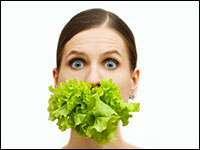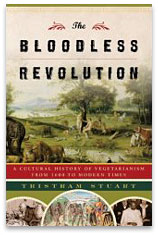Edible Media takes an occasional look at interesting or deplorable food journalism on the web.
It’s been a rough couple of months for meat eaters. In late November, the FAO issued a startling report claiming that livestock production emits fully 18 percent of global greenhouse gases — more than all the automobiles in the world.
Then out comes a big book: The Bloodless Revolution by British scholar and proud “freegan” Tristram Stuart. The book seeks to trace the “cultural history of vegetarianism from 1600 to modern times.”
The existence and long history of vegetarianism should make us meat-eaters squirm a bit. Who are we to make other sentient creatures suffer and die painful deaths, so we can gain our sustenance in a world with many non-animal choices on offer?
It’s not inconceivable that our meat habit could one day seem monstrous. As Laura Miller put it in her review of Stuart’s book on Salon:
We, like the people of the early 1800s, could be living through a period of slow but profound ideological change. … In the future, right-thinking people might look back at us meat eaters with the same disapproval we heap on those who considered slavery acceptable 200 years ago.
Few would deny that out current mode of meat production is monstrous. The dirty business of slaughter takes place off-stage, so to speak. Most Americans blithely fill up on meat without knowing or caring about what goes on in fetid feedlots or brutal (for workers and animals alike) slaughterhouses.
In his elegant review of the Stuart book for The New Yorker, Steven Shapin brings up a bracing fact about U.S. meat consumption. Every year, the average American consumes 275 pounds of meat — up from 238 in 1981.
That means the average American ingests three-quarters of a pound per day. When you account for vegetarians and people who eat meat only occasionally, that figure is even more breathtaking.
Worse still, other nations are following the the U.S. lead. Shapin informs us that in China, per capita meat consumption has surged from from 33.1 to 115.5 pounds since 1981. That’s amazing.
Michael Pollan has made the point that explosive growth in meat consumption would not have been possible without the industrialization of farming. Essentially, when grain yields surged in the second half of the 20th century, prices tumbled and it began to seem economical to start feeding farm animals huge amounts of grain instead of grass. That in turn led to feedlots and vast centralized slaughterhouses, and the price of meat fell, turning it into a daily expectation rather than a luxury.
But if voracious meat consumption is related to the mechanization of agriculture and its marginalization from most people’s lives, so might be vegetarianism. Shapin, in his New Yorker essay, makes a provocative point:
Those who kill animals in the course of their working day may quickly become habituated to it, and to dismiss this effect as mere desensitization effectively discounts great knowledge of animal death in favor of slight knowledge. Similarly, those who like to romanticize country people are frequently discomfited by their uncuddly ways with livestock. A major source of the sympathy with animal suffering that developed so strongly from the Enlightenment may well be the pattern of urbanization that removed so many of us from daily experience of how our food is produced. Why is it “natural” not to know very much about “nature”? [Emphasis in original]
The answer, then, might not be to ban meat outright (which, as relentlessly rising consumption patterns are telling us, is highly unlikely). Rather, it might be to revalue and spread the “experience of how our food is produced.”
After all, the pre-Enlightment peasants who presumably treated their animals so unsentimentally didn’t eat much meat. They respected it as a delicious, dense store of nutrients and learned to make it stretch, giving the world the immortal (I hope) art of charcuterie.
Moreover, a renewed, broad-based knowledge of where food comes from will reestablish something that vegetarians and vegans sometimes forget: that organic agriculture in any meaningful sense relies on diversified farming — crops and livestock tended in close proximity.
But as a committed omnivore who is nevertheless appalled by feedlot agriculture and stunned by Americans’ meat-eating gluttony, I’ve got nothing but respect for vegetarians and vegans.
A deal with seitan

Speaking of vegans, I loved the article in last Wednesday’s New York Times food section about Brooklyn vegan chef Isa Chandra Moskowitz.
While I’m not about to abandon butter, eggs, and cream in dessert-making, I have no doubt that her confections are excellent. Why? Because of this bit:
Moskowitz … does not particularly like to talk about tofu. Ditto seitan, tempeh and nutritional yeast. “I think vegan cooks need to learn to cook vegetables first,” she said last week during a cupcake-baking marathon. “Then maybe they can be allowed to move on to meat substitutes.”
Amen. I don’t mean to knock vegans; if anything, their prohibitions force them into paying more attention to cooking than their McDonald’s-gorging peers. Yet anyone who’s been served monstrosities like vegan Sloppy Joes can give Moskowitz a witness.
Read Ethicurean
I love the food blog Ethicurean, whose posters have such decidedly non-vegan handles as Butter Bitch, Dairy Queen, Omniwhore, and Miss Steak.
Anyone who wants to keep up with the blitz of food news/commentary must RSS this blog.
And I’m not just saying that because they’ve often commented favorably on my own work. (Full disclosure: I discovered Ethicurean through the egregious procrastination tactic known as egosurfing.)



